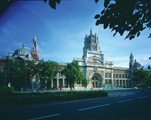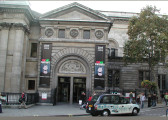Dreams Do Come True – The Story of the Supremes from the Mary Wilson Collection
Originally published in July 2008 in American in Britain Magazine
Some dreams come true, some do not. This is the story about how the dreams of Mary Wilson and three teenage African-American girls, the Supremes, came true. Set in the context of the American Civil Rights movement in the 1960s, video & archival material provide the background. Glamour and fame characterise the rags-to-riches career of the Supremes. Their wardrobe of slinky, satin and sequined stage costumes is unmissable.
You got to have a dream,
If you don’t have a dream,
How you gonna have a dream come true?
-lyric-‘Happy Talk’ from South Pacific- the musical 1949
Some dreams come true, some do not. This is a story about how the dreams of Mary Wilson and three teenage African-American girls, the Supremes, and the dreams of Berry Gordy, founder of Motown Records in Detroit, Michigan came true. But it is also the story of the American Civil Rights movement in the 1960s when Martin Luther King’s Dream made progress but stopped short of being fully realized when he was assassinated in 1968.
Mary Wilson’s story began in Detroit, Michigan in the late 1950s when rock and roll and R&B music were all the rage. Mary and her pals dared to dream an ‘impossible dream’. Aspiring to a glamorous life, they idolized role models like Nat ‘King’ Cole, Sam Cooke, Sarah Vaughan and rockers like Little Richard, Chuck Berry and many others. In 1959 Ella Fitzgerald and Count Basie were the first African-Americans to win Grammy awards. In that year a savvy Detroit ex-boxer, Berry Gordy, saw that it was time for soul and showbiz glitz to get together. He founded Motown Records in 1959 with an $800 loan and never looked back. Motown became the most successful black owned business in America at that time. Gordy’s vision was spelled out in the company slogan “The Sound of Young America”.
It was hardly surprising that Mary and three other sixteen year old girls called The Primettes, a singing group, were determined to find their way in the music business. At their first audition, Gordy told them to “go away and finish high school”. Undeterred, they continued to hang out at the Motown studio. One day a backing group for a Marvin Gaye recording session did not turn up. “We’ll do it”, they clamored. In 1961 they auditioned a second time and Gordy signed them, insisting that they change their name. The Supremes were born! From that moment on, Mary Wilson, Diana Ross and Florence Ballard (and Betty McGlown who left in 1960) made their way into the commercial world of soul and pop showbiz as a trio. They had stepped out of the wings of Detroit’s federally funded housing projects to become the most popular female singing group of the Sixties. They reigned ‘supreme’ for 17 years. By 1965 the Supremes had had five consecutive number one hits – and had sold more records than the Beatles.
Mary’s story and the V&A exhibition is far more than a Supremes dress-up show. Visitors enter the exhibit on the ground floor in the Fashion Gallery. A major theme in the exhibit is the synthesis of black culture with the political climate of the time. The show begins with maps charting the chronology of the ‘Great Migration’ of blacks from the rural South to northern cities in the 1920s and 1930s. The ‘Great Migration’ brought religion, culture and black music North. This context sets the scene for the emerging and unprecedented success of the Supremes. They rose to fame in the midst of tumultuous racial tension in1950s and 60s America. Videos and archival footage remind us of the events which took place.
Although early recordings of the Supremes for Motown did not make it into the US Top 100 charts, Gordy’s ambition for their eventual success was undeterred. Berry called in Maxine Powell, an elegant black style consultant from Chicago. This was Motown’s ‘finishing school’ and Powell was, in a sense, the in-house Emily Post. Her job was to hone the social skills and stage techniques, and develop the personal charm of future stars. It was a training that resembled old Hollywood charm schools and the Supremes were outstanding students. Maxine wrote: “The artists were diamonds in the rough, and Motown had the good sense to polish them”…(she added) “artists should be able to converse with kings and queens”. Be sure to catch the video clip of Maxine in the exhibit. Mary Wilson acknowledges the importance of Maxine’s lessons in refinement, conducting conversation, and how to behave on stage. Even though Powell insisted that her approach was color blind, she managed to put the finishing touches on recording artists so they could cross the black-white divide in the entertainment world of 1960s America. Gordy was careful to control his performers’ public image, dress, manners and choreography for crossover appeal. And while he ignored the criticism that he had sold out by creating homogenized Supremes, Gordy persevered and soon his investment paid off.
When television took the concert stage into the living rooms of America the impeccable style of the Supremes was a large part of their success. Dressed in simple flowing gowns made in silk, wool and often skin-tight satins, they were mesmerizing to watch. The Supremes were the first black female vocal group to appear on the Ed Sullivan television show in 1964. They performed at Lincoln Center in New York and went on their first UK tour in 1965. Numerous engagements and touring dates took them all over the world. In November 1968, they gave a Royal Command Performance at the London Palladium in the presence of the Queen Mother.
Much of the Supremes’ success is attributed to the songs written for them by the in-house Motown team, Holland-Dozier-Holland: two Holland brothers and Lamont Dozier. HDH worked up many tunes for the Supremes, and when Motown released ‘Where Did Our Love Go’, (by HDH) in 1964, it reached No.1 the US charts and No. 3 in Britain. Another song, ‘Baby Love’, hit No. 6 in the same year. Musical arrangements were meticulously choreographed by Cholly Atkins and Gil Askey became the group’s arranger. Atkins tutored in stage gestures which he integrated with choreography. Before long the Supremes’ style communicated a sophisticated and confident chic. Many of the songs and recorded performances have easily stood the test of time and can be viewed in the exhibition and on YouTube. In their early days, some saw the Supremes as role models for young black Americans. When they released ‘Love Child’ in 1968, a number which dealt with the controversial theme about a child born to unmarried parents, their popularity appeared undiminished. Clearly times and attitudes were changing and ‘Love Child’ reached No. 1 in the US charts.
The added glitz of their wardrobe was and still is sensational. It is a delight to visit the exhibition and see how well preserved the Supremes’ ‘work clothes’ are. Showcases feature a wide array of stage costumes. And video footage in the exhibition confirms how terrific they looked and how talented they were. Stop at the bottom of the Hollywood stairway where elaborate performance gowns flank the stairs. Stand there and look up at the video of their concert numbers. What a great show! Undoubtedly, it is to Mary Wilson’s credit that she collected and stored the costumes for 30 years. As each member left the group she hung on to wigs, hats, capes, jewellery and boas. A sample is on display. All the outfits deserve your attention but perhaps the most spectacular are the beaded gowns with big rhinestones, weighing 35 pounds each, which were worn at a London performance for the Queen Mother. It was that sequined polish which placed them in the spotlight of an adoring public.
When the Supremes’ break-up came, it was not a surprise. For many years, Diana Ross had been the lead singer with Mary and Florence acting as back-up. In 1970 Diana Ross and the Supremes gave their final performance together. They made outstanding musical history as the most successful black singing group in the 20th century. With over 20 million records sold, they were second only to the Beatles’ record sales. It seems fitting to end this piece with a quote from Mary Wilson herself: “We were three little black girls from Detroit, Michigan. My mother couldn’t read or write. The more you dare to dream, the more of your dreams you can make come true.”
***************************************************************************
Who were the Supremes?
1959-1960 The Primettes: Florence Ballard, Betty McGlown, Diane Ross, Mary Wilson
1960-1961 The Primettes: Barbara Martin, Florence Ballard, Diane Ross, Mary Wilson
1961-1962 The Supremes: Barbara Martin, Florence Ballard, Diane Ross, Mary Wilson
1962-1967 The Supremes: Florence Ballard, Diana Ross, Mary Wilson
!967-1970 Diana Ross and the Supremes: Cindy Birdsong, Diana Ross, Mary Wilson
References:
Dreamgirl: My Life As A Supreme by Mary Wilson. St. Martin’s Press. New York 1986
The Story of the Supremes by Daryl Easlea. VA Publishing. London 2008 with a foreword by Mary Wilson
V&A Exhibition Dates: 13th May – 19th October 2008. Entrance Fee
The exhibition will move to The Grundy Gallery, Blackpool, from November 2008 to January 2009
Birmingham Museum and Art Gallery from March to June 2009
British Empire and Commonwealth Museum in Bristol from July-August 2009
CONTACT: Abby Cronin – Email: artsjournalist@abbycronin.co.uk
Web Address: www.abbycronin.co.uk




